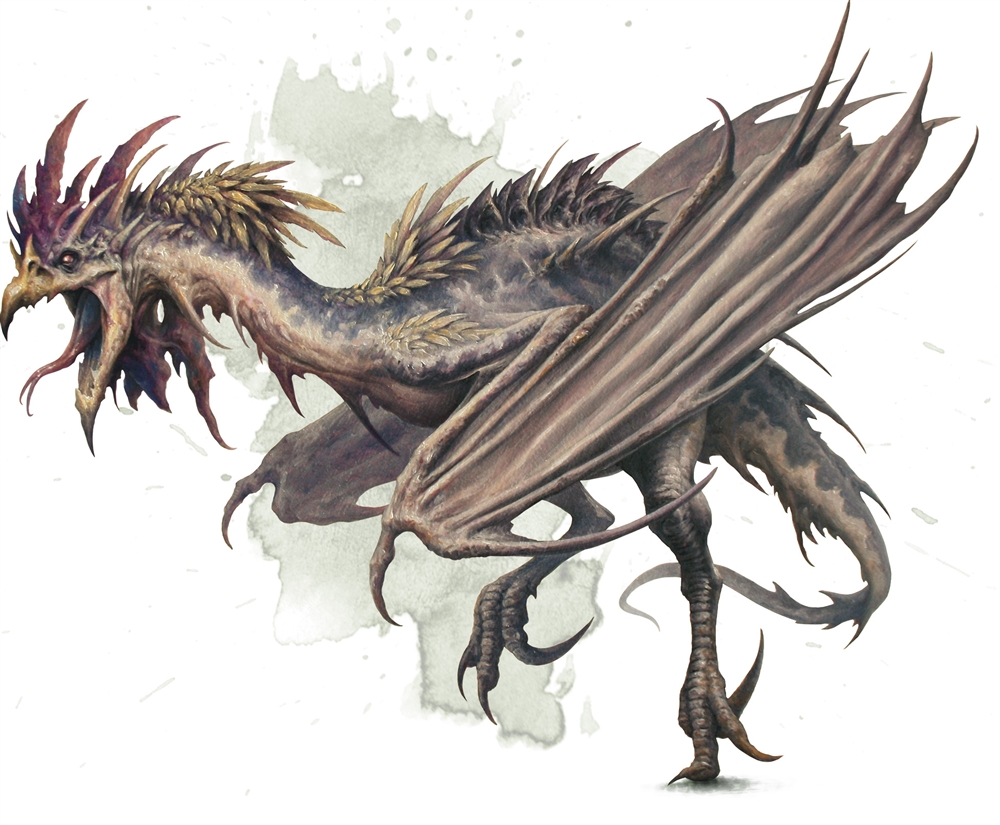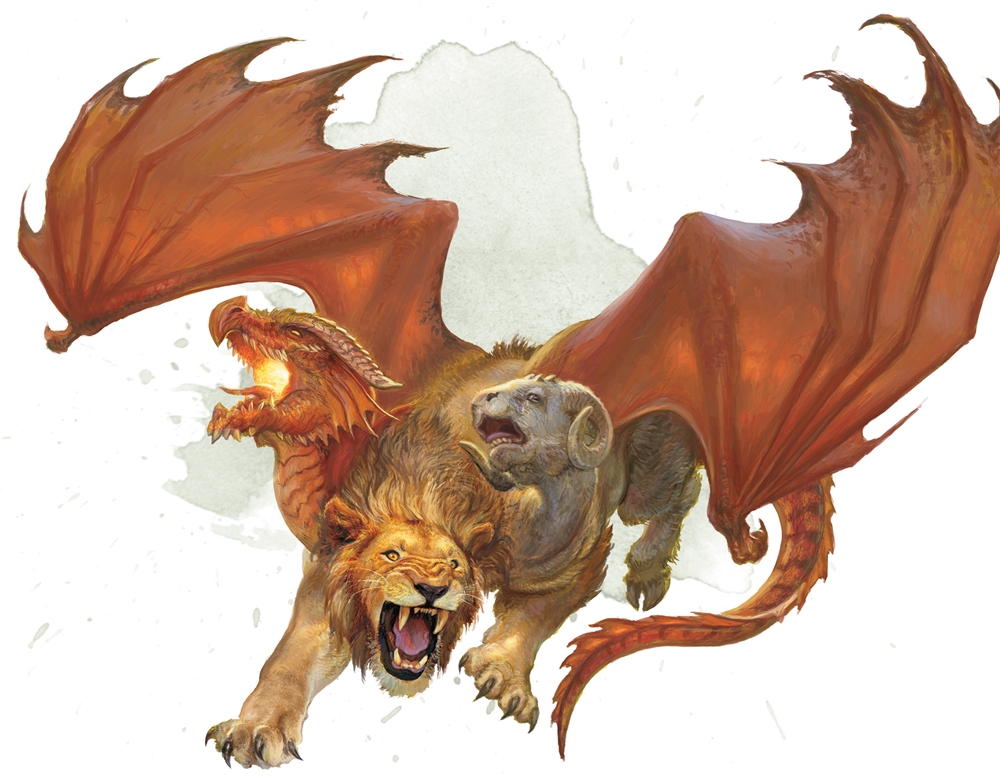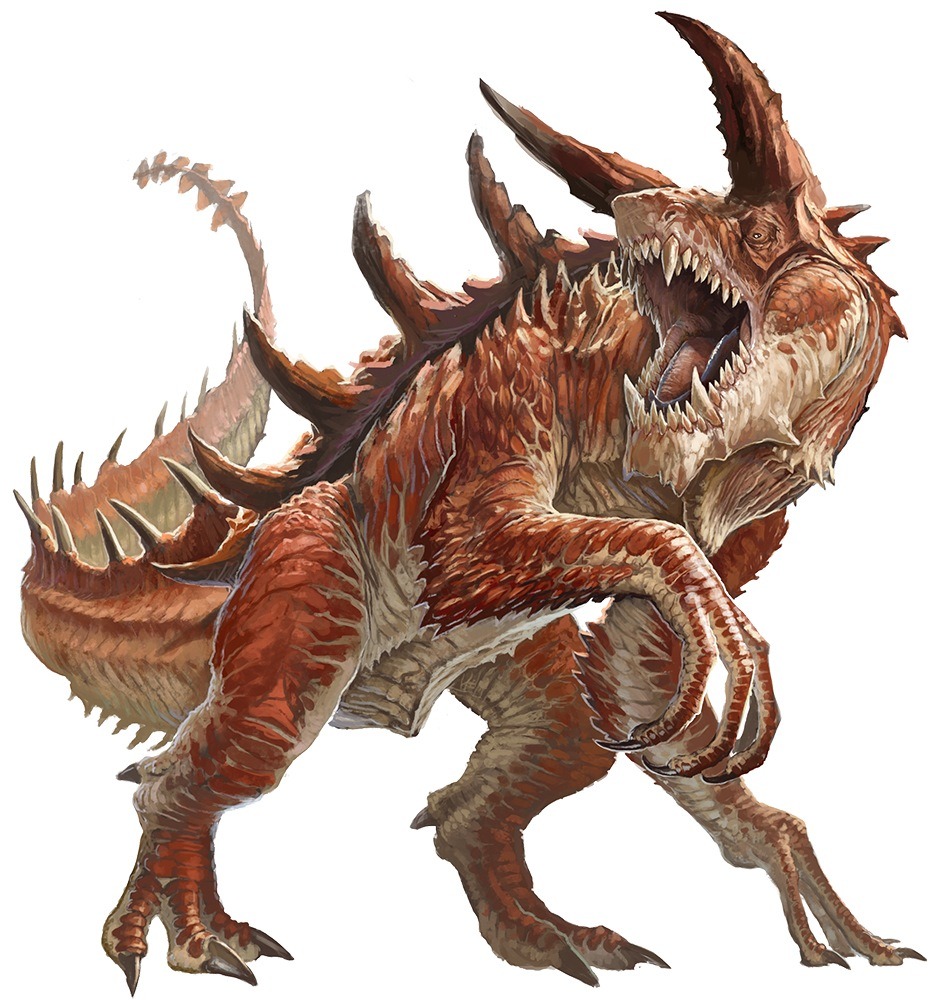Last Updated on January 22, 2023
Dungeons & Dragons 5e is ostensibly a game about fighting monsters — some of whom are more monstrous than others.
From the lowly Cockatrice to the planet-shattering Tarrasque, there is no category of creature more varied, more dangerous, and more fun than Monstrosities.
Welcome to our guide to Monstrosities in D&D 5e, one of the largest and easily most diverse groups of creatures in the Monster Manual and beyond.
Our goal today is to provide you with an accessible, searchable guide to some of our favorite examples.
What Are Monstrosities in DnD 5e?
Monstrosities are a category of creature in Dungeon & Dragons 5e that are monsters in the purest sense of the word — they are unnatural, dangerous, and usually hostile.
Other than that, there’s actually relatively little that connects the creatures in this classification.
Though not beasts, some monstrosities seem to be more naturally occurring than others, like the Carrion Crawler, the Bullette, the Purple Worm, and even the Kraken, which all tread close to the line between monster and big, nasty animal.
Other monstrosities are hellish (one might say chimeric) combinations of multiple existing animals, like the Minotaur, the Drider, and the iconic Owlbear, suggesting that they were created as some kind of magical mishap or perhaps as a cruel joke by a thoughtless god.
Of course, many creatures that took the form of impossible hybrids between existing animals are drawn from our own real-world mythologies.
Many medieval and ancient monsters, including the Cockatrice, Basilisk, Centaur, Hippogryph, Harpy, Manticore, Chimera, and Medusa are considered monstrosities.
But so are some uniquely D&D creatures, the invention of which is credited directly to Gygax and Arnseon, like the Displacer Beast, the Umber Hulk, and the Mimic.
Also, we can’t use intelligence as a way to spot a monstrosity.
While many of the creatures in this list are essentially instinctual predators, there are some that are highly intelligent, like the Spirit Naga and the Doppelganger (which is also a playable race).
So yeah, there are very few characteristics that describe all monstrosities (hybridization is probably the most common trait, although it’s not always present).
In fact, the only one I can think of is that, given half a chance, any monstrosity will probably have a very good try at ruining your day.
A Miscellany of Monstrosities by CR

Cockatrice (CR 1/2)
A classic medieval monster resembling a nightmarish hybrid of lizard, bird, and bat. The cockatrice’s party trick is its ability to turn flesh to stone.
Cockatrices wouldn’t be such a huge problem for adventurers if they didn’t basically have the same response to everything as an irate chicken: fly at it pecking, squawking, and flapping its wings like crazy.
Now imagine the chicken has a bunch of knives taped to it, and if it stabs you, you turn to stone and die.
Rust Monster (CR 1/2)
Forget dragons, vampires, and poisonous snakes, rusk monsters are the scariest monsters in D&D, mostly because anything metal they touch instantly starts to corrode and decay, including any metal weapons that hit it.
Harpy (CR 1)
Evil, flying women from Greek mythology, harpies blend the body, legs, and wings of a vulture with the torso, arms, and head of a female human.
These creatures hunt in packs, carrying away livestock, children, and even full-grown adventurers if they’re hard pressed. In D&D, harpies can also sing a siren song that lures hapless travelers to their deaths.
Hippogryph (CR 1)
A hybrid between an eagle and a horse, Hiipgryphs have magical origins but were created so long ago that they’ve more or less integrated into the natural order — although this means they are the favored prey of dragons, wyverns and griffons.
They are fierce and mate for life. A hippogryph raised from birth in captivity will make for an excellent flying mount.
Ankheg (CR 2)
Large, mantis-like insect men that burrow through the earth, lying in wait until the telltale vibrations of a passing creature cause them to burst onto the surface, seizing their prey with jaws that can cut a tree in half.
When threatened, an Ankheg can also spit a line of caustic acid at anything that threatens it.
Carrion Crawler (CR 2)
Common inhabitants of battlefields, tombs, and charnel pits, Carrion Crawlers are large, chitinous centipedes that strip putrefying flesh from bone.
If they encounter live prey, their ringed, worm-like jaws are lined with paralyzing tentacles, allowing them to disable their attackers and feast at their leisure.
Centaur (CR 2)
Proud, reclusive hybrids of human and horse, centaurs avoid conflict when possible, but they are fierce warriors nonetheless. They roam mild and hot climates in nomadic herds, hunting and gathering for food.
Griffon (CR 2)
The apex predator of low-level play, Griffons combine the physical properties of a lion and an eagle. They plague towns on the edge of civilization, stealing livestock and travelers from the roads.
Like lions, they often hunt in small prides and build lairs high atop cliffs. They are vicious foes, but they can also be trained from birth to be fiercely loyal mounts.
Mimic (CR 2)
Shapeshifting predators that can perfectly take on the form of inanimate objects (from rocks and tree stumps to furniture) in order to get the drop on their prey, which they ensnare with sticky tentacles and devour with rows upon rows of razor sharp teeth.
Especially cunning mimics like to take on the appearance of something people actively want to open, like treasure chests.
Basilisk (CR 3)
A six-legged, reptilian horror with the ability to petrify its prey with a glance, rapidly turning them into a remarkably lifelike statue depicting their terrified final moments.
They dwell in dry caves and can be raised from the egg to be fearsome guard beasts.
Displacer Beast (CR 3)
Another six-legged horror, displacer beasts resemble large, jet-black panthers with six legs and a pair of prehensile tentacles protruding from their shoulder blades.
As a result of the strange magical mishap (or possibly a cruel fey-breeding program) that created them, these creatures constantly displace light so that they appear to be standing several feet away from where they actually are.
Doppelganger (CR 3)
Devious shapeshifters fond of misdirection and subterfuge, doppelgangers can take on the appearance of other humanoids as well as read the surface-level thoughts of others.
Manticore (CR 3)
Based on an ancient Sumerian myth, manticores are nightmarish combinations of a human face, the body of a lion, and the wings of a dragon.
They also have long tails that end in a cluster of deadly spikes, which the manticore can shoot at its enemies with deadly accuracy.
Born of some cruel magic experimentation, manticores are cruel predators and take great pleasure in stalking their enemies over great distances — sometimes in packs.
Manticores will often taunt their foes, offering a quick death if they stop fighting. They are not smart, but they can be reasoned with, especially if their selfish and vain natures are appeased.
Minotaur (CR 3)
The iconic bull-headed humanoid with a love of combat and a taste for blood, created in ancient rituals by dark cults.
Minotaurs are solitary carnivores that roam labyrinthine dungeons, twisting caves, primeval woods, and the maze-like streets and passages of desolate ruins.
All minotaurs have the ability to perfectly navigate these mazes, making them their ideal hunting ground.
Owlbear (CR3 3)
One of D&D’s most iconic low-level monsters, the owlbear is a massive, incurably angry bear with the head of an owl. These vicious creatures are hyper-aggressive, and will attack almost anything that stumbles into their territories.
Umber Hulk (CR 5)
A truly weird beastie somewhat similar to the Ankheg. Umber Hulks are insectoid burrowing creatures that break into underdark settlements in search of food.
Those who survive an attack by these creatures often can’t remember what it was that attacked them, thanks to the Umber Hulk’s brain-scrambling gaze.
A great option for a lower-level solo-monster fight that delivers something a bit more interesting than “big bug with multiattack.”

Chimera (CR 6)
This classic medieval monstrosity might as well be the mascot for this whole class of monster, combining the heads of a lion, goat, and dragon with the body of a lion and a dragon’s wings and tail.
This fearsome, multi-attack spamming, fire-breathing creature also has one of the best origin stories of any creature in D&D.
“Chimeras were created after mortals summoned Demogorgon to the world. The Prince of Demons, unimpressed with the creatures that surrounded it, transformed them into horrific, multi-headed monstrosities. This act gave rise to the first chimeras.”
Brutal.
Medusa (CR 6)
Another classic from Greek mythology, the medusa (I know, I know — medusa was a gorgon, but in D&D a gorgon is a type of giant metal bull, so here we are) is a terrifying foe, with snakes for hair, a petrifying gaze, and a longbow for good measure.
Like the basilisk, however, a medusa that’s tricked into meeting its reflection can turn itself to stone.
Hydra (CR 8)
Multi-headed reptilian monsters with several snakelike heads and a crocodile’s body — also plucked from Greek myths — hydras in D&D are a good deal less deadly than in the legend of Hercules.
They don’t grow back extra heads when you cut them off, but they’re still dangerous foes and practically impossible to sneak up on.
Spirit Naga (CR 8)
Cruel, spiteful snake people with a gift for enchantment magic, Nagas devote themselves to researching new spells and enslaving humanoid races around them — just like in the classic adventure N1 Against the Cult of the Reptile God.
Froghemoth (CR 10)
One of my personal favorites, mostly because it’s both incredibly dangerous and looks really, really stupid (call it my overdeveloped shadenfreude muscle, but players can usually justify dying to a red dragon; watching everyone come to terms with dying to something that looks like a drunken medieval monk’s drawing of a frog stuck in a bowl of udon noodles is way, way funnier).
Behir (CR 11)
Gigantic serpentine worm-dragons that live in caves and breathe lightning.
These creatures like to use their ability to move quickly in enclosed spaces to gain an advantage over their prey, and encountering one can lead to some fantastically claustrophobic, terrifying combat.
Remorhaz (CR 11)
Gigantic, fire-filled, insectoid ambush predators that burst from beneath the ice in arctic regions to devour anything smaller than a frost giant.
With a stomach full of lethal acid and a nasty mouthful of teeth, these monstrosities can punch well above their weight when dealing with powerful adventuring parties.
Roc (CR 11)
From far, far away, a roc looks much like any other bird. As it gets closer, however, its true size becomes apparent.
With a wingspan of 200 feet or more, these sky titans rival ancient dragons in size and will even treat giants as potential prey.
These solitary creatures (whose eggs are roughly the size of small houses) make nests from trees, tents, broken ships, and the remains of caravans they carry off, placing these massive tangles in mountain clefts out of the reach of lesser creatures.
Purple Worm (CR 15)
So Gygax, Arneson, Cook, and Moldvay were a bunch of Dune nerds. Who’d have guessed? Measuring hundreds of feet in length, the gargantuan purple worm buries its way through the underdark in pursuit of prey.
They are attracted to noise, erupting through solid rock to devour anything smaller than a hill giant whole, and if it needs to fight something too big to eat, a purple worm’s tail is tipped with a stinger coated in some of the deadliest poison in the known world.
Androsphinx (CR 17)
Sphinxes are installed (or install themselves, perhaps) as guardians of ancient temples, vaults, or even cities. These ancient, immensely powerful creatures are accomplished spellcasters and collectors of ancient knowledge and secrets.
In its lair an Androsphinx can even control the flow of time, causing intruders to rapidly age decades in a matter of seconds.
Kraken (CR 23)
“Below the thunders of the upper deep,
Far, far beneath in the abysmal sea,
His ancient, dreamless, uninvaded sleep
The Kraken sleepeth” — Alfred Lord Tennyson
The biggest, baddest, most terrifying thing in the ocean, the Kraken is a force of nature, of unbridled destruction more powerful than the strongest hurricane.
The Kraken can destroy buildings with a single blow, swallow ships whole, and conjure lighting storms around it.
Tarrasque (CR 30)
Held up as D&D 5e’s most apocalyptically dangerous monster (short of an actual god, of course), the Tarrasque is a magically immune, nigh-invulnerable Godzilla-sized dinosaur that can crush entire cities beneath its feet.
Truly the most monstrous thing in the Monster Manual.

There we go, folks. If you were unclear about what exactly constitutes a monstrosity before you started reading this list, I’m sure you’re twice as confused now.
Monstrosities are as diverse as they are terrifying, which is why I think they’re probably the most interesting category of monster in D&D 5e.
No matter the occasion — whether you’re hunting displacer beasts in the jungles of Chult or being stalked by doppelgangers through the streets of Neverwinter — there’s probably a monstrosity that fits the bill for your next adventure.
The list above doesn’t even begin to cover the true breadth and depth of this category of creature, but I hope it can serve as an intro to some of this classification’s most iconic examples.
You thought the owlbear was bad? Wait until you find out about the hook horror.
Until next time, folks, happy adventuring.
- About Author
- Latest Posts
I played my first tabletop RPG (Pathfinder 1e, specifically) in college. I rocked up late to the first session with an unread rulebook and a human bard called Nick Jugger. It was a rocky start but I had a blast and now, the better part of a decade later, I play, write, and write about tabletop RPGs (mostly 5e, but also PBtA, Forged in the Dark and OSR) games for a living, which is wild.
